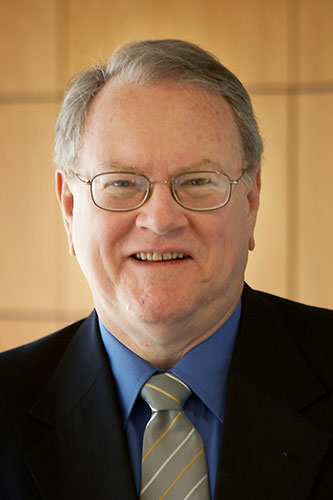Education
| BS | Biology / Chemistry | Bowling Green State University | Bowling Green, Ohio |
| PhD | Microbiology / Botany | University of Texas | Austin, Texas |
Research Description
Host-microbe interactions
The Soybean-Bradyrhizorium japonicum symbiosis: A major focus of research in the Stacey lab is the symbiosis between the bacterium B.japonicum and its host plant, soybean. The result of this interaction is the establishment of a novel organ, nodule, on the root of the host. Inside this organ, B. japonicum fixes atmospheric nitrogen, which the plant can use. Plant perception of lipo-chitin nodulation signals, produced by the bacterium, is essential for induction of de novo organogenesis, leading to nodule formation. The lab’s research is focused on plant recognition of this molecule and the signal transduction pathways leading to nodule development. The lab developed the soybean root hair system as a single cell model for systems biology and have published extensively on the use of this model to examine the functional genomic response to rhizobial infection.
Plant chitin recognition and fungal-plant interactions: The lab’s interest in legume-lipo-chitin recognition has led to a general interest in chitin recognition in plants. For example, chitin, released from the cell wall of pathogenic fungi, is a known elicitor of defense responses in plants. The lab cloned the plasma membrane receptor for chitin and work is continuing to study this receptor, its interacting proteins and general role of chitin signaling in plant innate immunity.
ATP as an extracellular signal in plants.
ATP is the energy currency of the cell but can also be released outside the cell where it plays an important signaling role. This function is well documented in animal systems but less so in plants. However, several published studies, including those from our lab, have implicated extracellular ATP as an important signal in plant growth and development, as well as the plant response to various stresses. A major recent achievement of the lab was the identification and cloning of the first plant receptor for extracellular ATP. Work is ongoing to characterize this receptor and fully explore the role of extracellular ATP in plants.
Soybean genomics and biotechnology
As part of the growing family of researchers at MU who are interested in soybean biology, the Stacey laboratory is contributing to the development of soybean genomic research. The goal of this research is to identify genes and traits that can benefit soybean agriculture. For example, at MU, the lab is developing, in collaboration with other laboratories, first-rate facilities for high-throughput molecular breeding of soybean and transformation capabilities for creating transgenic soybean with improved agronomic and/or nutritional traits.
Notable Honors and Service
- Mumford Outstanding Faculty Award, College of Agriculture, Food and Natural Resources, University of Missouri, 2013
- Fellow, American Society of Plant Biologists
- Fellow, American Academy of Microbiology
- Elected Fellow of the American Association for the Advancement of Science, 2008
- Distinguished Researcher Award, College of Agriculture, Food, and Natural Resources, University of Missouri, 2007
- Chancellor’s Award for Research and Creative Achievement, University of Tennessee, 1992
- Van der Klaauw Chair of Molecular Biology, Visiting Professorship at the Univ. of Leiden, Leiden, The Netherlands, 1990
- Van der Klaauw Chair of Molecular Biology, Visiting Professorship at the Univ. of Leiden, Leiden, The Netherlands, 1990
- Research Fellowship, Alexander Von Humboldt Stiftung, 1988
- National Science Foundation Postdoctoral Fellowship, 1979
- Robert A. Welch Predoctoral Fellowship, 1977-1978
Selected Publications
Hossain MS, Hoang NT, Yan Z, Tóth K, Meyers BC, Stacey G. (2019). Characterization of the Spatial and Temporal Expression of Two Soybean miRNAs Identifies SCL6 as a Novel Regulator of Soybean Nodulation. Front Plant Sci. 10:475. doi: 10.3389/fpls.2019.00475. eCollection 2019. [PubMed]
Wongkaew A, Asayama K, Kitaiwa T, Nakamura SI, Kojima K, Stacey G, Sekimoto H, Yokoyama T, Ohkama-Ohtsu N. (2018). AtOPT6 Protein Functions in Long-Distance Transport of Glutathione in Arabidopsis thaliana. Plant Cell Physiol. 59(7):1443-1451. doi: 10.1093/pcp/pcy074. [PubMed]
Chen D, Cao Y, Li H, Kim D, Ahsan N, Thelen J, Stacey G. (2017). Extracellular ATP elicits DORN1-mediated RBOHD phosphorylation to regulate stomatal aperture. Nat Commun. 8(1):2265. doi: 10.1038/s41467-017-02340-3. [PubMed]
Tripathi D, Zhang T, Koo AJ, Stacey G, Tanaka K. (2018). Extracellular ATP Acts on Jasmonate Signaling to Reinforce Plant Defense. Plant Physiol. 176(1):511-523. doi: 10.1104/pp.17.01477. [PubMed]
Cho SH, Nguyen CT, Choi J, Stacey G. (2017). Molecular Mechanism of Plant Recognition of Extracellular ATP. Adv Exp Med Biol. 1051:233-253. doi: 10.1007/5584_2017_110. Review. [PubMed]
Liao D, Cao Y, Sun X, Espinoza C, Nguyen CT, Liang Y, Stacey G. (2017). Arabidopsis E3 ubiquitin ligase PLANT U-BOX13 (PUB13) regulates chitin receptor LYSIN MOTIF RECEPTOR KINASE5 (LYK5) protein abundance. New Phytol. 214(4):1646-1656. doi: 10.1111/nph.14472. [PubMed]
Cao Y, Halane MK, Gassmann W, Stacey G. (2017). The Role of Plant Innate Immunity in the Legume-Rhizobium Symbiosis. Annu Rev Plant Biol. 68:535-561. doi: 10.1146/annurev-arplant-042916-041030. Review. [PubMed]
Hossain MS, Kawakatsu T, Kim KD, Zhang N, Nguyen CT, Khan SM, Batek JM, Joshi T, Schmutz J, Grimwood J, Schmitz RJ, Xu D, Jackson SA, Ecker JR, Stacey G. (2017). Divergent cytosine DNA methylation patterns in single-cell, soybean root hairs. New Phytol. 214(2):808-819. doi: 10.1111/nph.14421. [PubMed]
